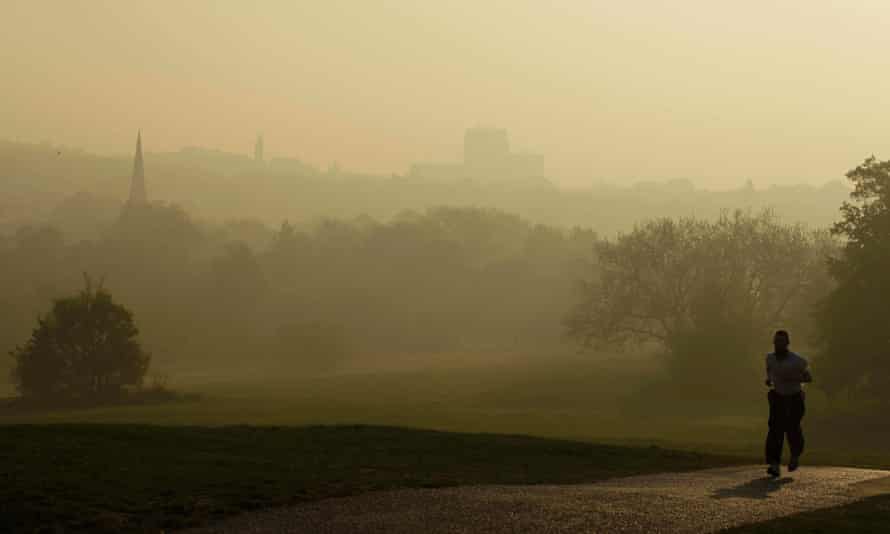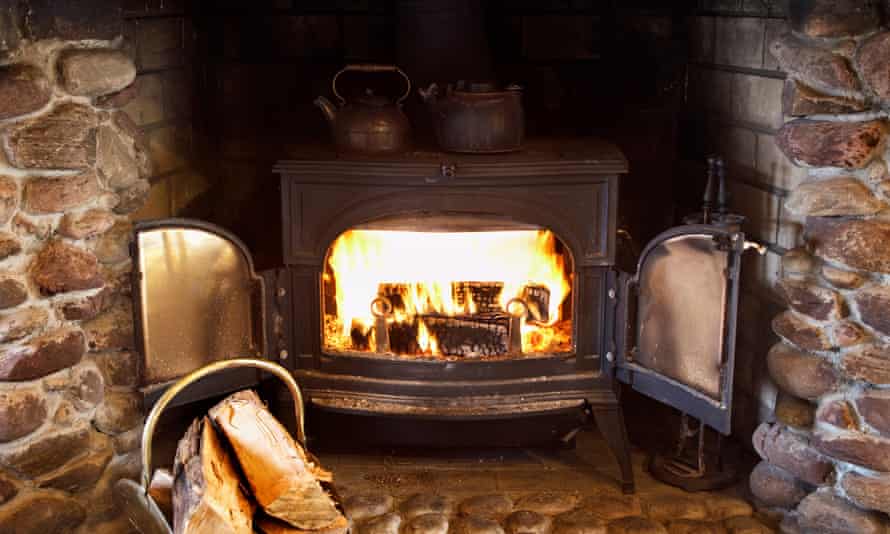Funny Memes About Wood Burning Stoves
E mma Meaden loves to sit in her north-west London flat, her dogs napping at her feet, watching the flames dance in her new wood stove. When she first moved in, she lit a few fires in the old-fashioned fireplace – but it was a poor way to heat her sitting room and she was intrigued by the stoves she'd seen at friends' homes in the country. Along with the savings on heating and the ambiance, Meaden liked the idea that wood was a renewable fuel – one that, she supposed, would shrink her carbon footprint. "I'm always trying to do the right thing," she says.
Like Meaden, many Britons have embraced the cosy, hearth-and-home feeling of burning wood. The government has helped propagate the notion of wood as a renewable fuel that saves money and the environment alike – an image that stove manufacturers have happily seized upon for their marketing campaigns.
The truth, though, is less pleasant than those hygge fantasies. Wood smoke is thick with the tiny particulates, known as PM2.5, that are linked to heart attacks, strokes, cancer, dementia and various other ailments. What's more, the claims about a climate benefit from wood use are questionable.
Cars and trucks get more attention but nationally, domestic wood burning is the largest single source of PM2.5. According to one analysis of government data, it produces more than twice as much as all road traffic. While concerns about diesel vehicles focus largely on the nitrogen dioxide they produce, the evidence tying particulates to death and disease is even more powerful.
According to Leigh Crilley, an atmospheric chemist at the University of Birmingham, wood smoke also carries more carcinogens than diesel or petrol exhaust.
The increasing popularity of wood fires, scientists warn, threatens to erase any progress big cities might achieve in reducing pollution from traffic. "It's overtaking the gains we're making," Crilley said.

One study from 2014 found that wood smoke was adding more particle pollution to London's air than the first two phases of the city's low-emission zone were expected to remove. In London and Birmingham, King's College researchers reported wood accounted for up to 31% of locally produced particulates. And across Europe, wood burning is worsening pollution in capitals such as Paris, Berlin and Lisbon.
No smoke without fire
Meaden is correct that using a stove is far better than burning an ordinary "open fire". Not only are open fires – the ordinary, fireplace kind – highly polluting, burning wood on them is illegal in the "smoke control" areas common in British cities, where wood may only be burned in an approved stove. Only "smokeless" fuel – specially made briquettes or coals; not wood – can be burned in open fires.
Many people don't realise that, says Simon Birkett, founder of the Clean Air in London. "Just because you happen to have an open fireplace in Wandsworth or Richmond or something going back 100 years, doesn't mean you can burn wood. It was banned in 1956."
But wood stoves still add an extra dose of particles into the air: in fact, a wood-burning stove emits more particles per hour than a modern diesel lorry.
What's more, the climate benefit may well prove just as illusory as that of diesel, another supposed wonder fuel.
In the 00s, tax breaks encouraged drivers to buy diesel cars in the hope that their mileage efficiency would reduce overall carbon emissions. Today, diesel's contribution to Europe's dirty air is clear. Studies have shown that the climate boon didn't pan out as expected.
"We have yet another stupid decision," says Birkett. "In the same way they myopically pursued diesel, they have also myopically pursued wood burning."
Just as many car makers until recently promoted diesel as clean and green, manufacturers of wood stoves and boilers tout their products as sustainable.
"Wood is one of the most environmentally friendly fuels that can be used," boasts the Stove Industry Alliance. "Virtually carbon neutral."
The reality is more complicated. For industrial-scale burning – in power plants such as Drax in North Yorkshire, for example – burning wood pellets shipped in from the US was found to be worse for the climate than coal.
For domestic boilers outside of the cities, the government actively encourages wood burning through the renewable heat incentive subsidy. (This does not apply to the smaller wood stoves favoured in cities.) Those systems may bring some carbon savings, but only if the trees are replaced with new ones, and even then, it takes decades for the emitted carbon to be reabsorbed – a critical gap given the urgent need to slash greenhouse gas emissions. The picture is further complicated by the sooty black carbon in wood smoke, which is itself a driver of climate change, although less well-understood than carbon dioxide.
"There's lots of caveats," says Crilley, who believes wood's climate benefit only comes in "an ideal world which doesn't exist".

Patricia Thornley, a professor of sustainable energy at the University of Manchester, argues that wood has an important role to play in reducing carbon emissions from heat, because there are few good alternatives. But it's not appropriate in city centres, she says.
If there is a benefit, it comes at a steep price. Particle pollution is closely correlated with mortality rates: higher levels equal more deaths. And particles can travel long distances: wood smoke from rural burning can affect the air in more densely populated places. Studies have found lower rates of death, and of heart and breathing problems, where domestic wood burning is limited.
Moreover, any climate gain is premised on wood replacing a fossil fuel such as gas – a swap that, in the case of stoves or fireplaces, often isn't the case.
In cities, fires tend to be more of a lifestyle choice. "It's the guy coming home from work and picking up a bottle of wine and some logs," says Will Rolls, author of The Log Book. "You're not competing against gas and oil, you're competing against restaurants and cinemas."
Adding to the danger is the reality that some owners use their stoves improperly, burning waste wood such as pallets, which often contains toxic chemicals, or using logs with high moisture content.
'Engulfed in smoke'
In Stockport, Carolyn Beesley says her neighbour's wood stove creates a smoky smell that lingers for hours and has exacerbated her asthma.
"I might have my washing out, I might be out in the garden enjoying the sunshine. I don't want to be engulfed in that cloud of smoke," Beesley said. "I'd expect it in the country, but I didn't choose to live in the country."
The mayor of London, Sadiq Khan, asked the Department for Environment, Food and Rural Affairs (Defra) in September for the power to ban solid fuel use (wood, coal and the like) in high-pollution areas of the city, starting in 2025, which would require amending the Clean Air Act.
Defra, which plans to release an air quality strategy for consultation later this year, has called for evidence on much more limited measures. The department said it would not ban domestic burning, or prevent the installation of wood stoves. It said it might take action on the use of insufficiently dried or seasoned wood, which produces more smoke, and was considering granting local authorities new powers to deal with persistent smoke offences.
To Meaden, it's a familiar story. Years ago, she said, she accepted similar assurances about a different fuel being touted as climate-friendly, and bought a diesel car. "Everyone said it was the right thing to do."
Follow Guardian Cities on Twitter, Facebook and Instagram to join the discussion, and explore our archive here
Source: https://www.theguardian.com/cities/2018/feb/22/wood-diesel-indoor-stoves-cities-pollution
0 Response to "Funny Memes About Wood Burning Stoves"
Post a Comment